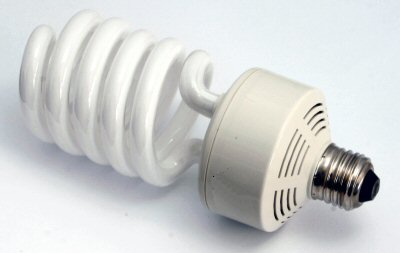|
Energy Savings Using Voltage
Bucking Transformer
I have read that some people have installed a large inductor in series with their
homeís electrical supply to help reduce power consumption. The idea is that
the inductor would have the effect of lowering the AC voltage by shifting the phase
relationship between voltage and current. Could such a device really reduce
power consumption and how much would it save? |
 |
| Many home appliances,
such as laptop computers, desktop computers, TVs, DVD players use universal AC to DC
power supplies and draw the same amount of power from the power line, regardless of
the input voltage. So, I donít think that lower AC voltage would have any
effect with those loads. |
| Other loads such as light
bulbs, space heaters and many fluorescent lamps will draw less power if the voltage
was lower. A lower voltage would mean less light from a lamp but perhaps that
would be acceptable. A compressor for an air conditioning unit might and a
blower motor for a furnace would both run slower. A microwave oven, convection
oven and stovetop burners should also draw less power. However, it might take
longer to cook food if the temperature was lower so a lower voltage may not really
work for those appliances. But, overall, maybe about half of all the power
used in a typical home would indeed draw less power if the AC line voltage supplied
to those loads was lower. |
| How could you lower the
AC line voltage in a home? One way to do this is with a transformer. I imagine
a special type of transformer called an ďautotransformerĒ being used. This
device would be wired into the 120/240 power lines as shown below. The 240vac
input is typically split into two 120vac sides. The transformer would buck the
120vac down to perhaps 110vac. In an autotransformer, the device only has to supply
the voltage difference and can therefore be much smaller than a fully isolated
transformer. Even with a typical 200 Amp service rating on each side, the
autotransformer would only have to be rated at about 4KW. It could be housed
in a junction box, mounted next to the main circuit breaker box. |
|
|
| Letís say a house
averaged 2KW of power. At that power level about 50KW hours of energy would be
needed each day. That is 1500KW hours per month. At the going rate of $0.1 per
kilowatt hour, the average monthly electric bill would be $150. Letís assume
that 50% of the electrical power could benefit from a lower voltage. That puts
the lowered monthly average at 750KW hours. |
| The power reduction in
those loads that would benefit from a lower voltage track a square law function with
respect to the voltage change. This means that when going from 120vac to
110vac, the power reduction is the square of the ratio of 110vac/120vac or 0.84.
This corresponds to a power reduction of 16%. Therefore, of the 750KW hours of
typical monthly use that could be lowered would be reduced to 630KW hours.
This is a savings of 750 Ė 630 or 120KW hours. At the going rate of $0.1 per
kilowatt hour, the net savings in energy would be about $12 per month. After
15 years that would add up to $2160.00. That just might be enough to buy the
big transformer and have it installed on a house. So, after 15 years, the
installation of this big transformer might pay for itself. |
 |
Now, suppose instead of the big
transformer, you spent just $50 and replaced 5 100 watt incandescent lamps with
5 compact fluorescent lamps, each drawing 25 watts. Letís say that those
lights were used 12 hours per day. The power reduction would be 375 watts and
the energy reduction would be 4.5KW hours per day or 135KW hours per month.
That is a savings of $13.5 per month. In less than three months, the
energy savings would exceed the $50 investment. After that, the homeowner
would save about $160 per year. That sure sounds like a better deal than
the transformer. |
|
| So, in conclusion, yes,
it does look like a device wired in the AC input of a homeís power line, to lower
the AC voltage, might indeed save some money but it might take over 15 years to see
a return on the investment. A much better way to lower the cost of electricity
is to change out some incandescent lamps to more efficient fluorescent lamps. |
|